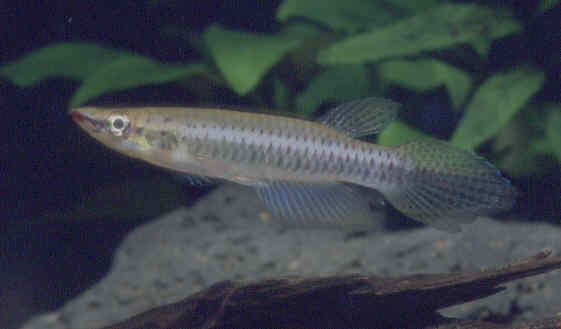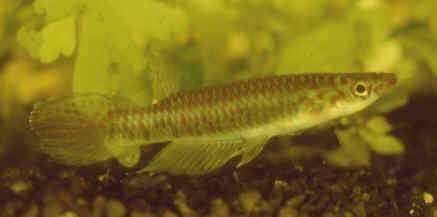Epiplatys barmoiensis Scheel 1968

E.barmoiensis. Photo courtesy of Ed Pürzl.
| Meaning of Name |
From Barmoi. |
||
| First Description |
Scheel JJ. 1968. Rivulins of the Old World Vol 1. TFH Publications 102-103, p 453-454, figures. |
||
| Size |
6.5 cm |
||
| Meristics |
|
||
| Karyotype |
n = 17, A = 25 (Scheel 1972) |
||
| Sub-Genus |
Epiplatys |
||
| Group |
bifasciatus |
||
| Synonyms |
|
||
|
Populations
|
Rokupr Pumping Station. SLCD 84 / 8 - Collected by Christian Cauvet & Jérôme Detienne, KCF in November 1984. |
||
| Type Locality |
Rokupr, western Sierra Leone. |
||
| Distribution |
Southern coastal Guinea through Sierra Leone & into western coastal Liberia. http://homepage.uibk.ac.at/homepage/c102/c102mr/epiplaty/barmoien.htm |
||
| Habitat |
Usually under forest cover in swampy areas & small rivers. |
||
| Distinguishing Characteristics | Adult males have long extensions to the pectoral fins. I once thought this was only found on this species but I also noticed it in large males of E.fasciolatus imported from Guinea. See http://www.bka.org.uk/imports1.shtml | ||
| Colour/Pattern Variability | Low | ||
| History |
Schultz originally identified the first known fish from Liberia as E.bifasciatus in 1942. 15 specimens were deposited in the U.S. National Museum. Clausen collected E.barmoiensis near Monrovia in 1965. These were said to have been caught in 'savannah - swamp'. All fish perished on their way to Copenhagen. Roloff collected them near Barmoi, western Sierra Leone in 1965. A pair from this collection were given to Scheel. In this biotope E.bifasciatus were also found. |
||
| Breeding Notes |
Regarded as difficult although I reproduced them without too much problem. They are a little slower at spawning than most other members of the genus. Eggs are laid in top & bottom mops but are not prolific. I used rainwater to breed them with a little salt added to the water. Hatching in water takes around 14 days. Sexual maturity takes around 8-9 months. |
||
| Diameter of Egg | |||
| Remarks |
It has been stated that eggs are susceptible to fungus although I did not find this. Also, it has been reported that fish are susceptible to pollution, though I have kept them in planted tanks without water change for many months. |

